
- Home
- Travel Packages
- Top Destination
-
Travel Attraction
By Category
Top Attraction

- Travel Agents
- Car Rentals
- Hotels
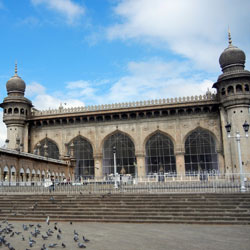
About The Mecca Masjid The Mecca Masjid, located in Hyderabad, India, is one of the oldest and largest mosques in the country. It is a revered place of worship for Muslims and a popular tourist attraction for visitors from all over the world. The mosque is known for its grand architecture, historical significance, and spiritual importance. Architecture of Mecca Masjid The Mecca Masjid is a prime example of Islamic architecture, with its impressive domes, arches, and intricate carvings. The mosque is made of granite, which was brought from a single rock and handcrafted by skilled artisans. The highlight of the mosque is its main prayer hall, which can accommodate thousands of worshippers at once. The structure of the mosque is adorned with exquisite floral and geometric designs, adding to its charm and beauty. History The construction of the Mecca Masjid began in 1617 during the reign of Sultan Muhammad Quli Qutb Shah, the fifth ruler of the Qutb Shahi dynasty. It took nearly 80 years to complete the mosque, with the final touches being added in the 19th century by the Mughal Emperor Aurangzeb. The mosque gets its name from the bricks brought from the holy city of Mecca, which were used in the construction of the central arch of the mosque. Over the years, the Mecca Masjid has witnessed several historical events and continues to be a symbol of religious harmony and unity. Best Time To Visit The best time to visit the Mecca Masjid is during the months of October to March, when the weather is pleasant and ideal for exploring the city of Hyderabad. It is also recommended to visit the mosque during the holy month of Ramadan, when the mosque is beautifully decorated and attracts a large number of worshippers. How To Reach The Mecca Masjid is located in the Old City area of Hyderabad, making it easily accessible by various modes of transportation. Visitors can take a taxi, auto-rickshaw, or public bus to reach the mosque. The nearest railway station is the Hyderabad Deccan Railway Station, which is just a short distance away from the mosque. For those traveling by air, the Rajiv Gandhi International Airport is the closest airport to the Mecca Masjid. Visitor Tips When visiting the Mecca Masjid, it is important to dress modestly and respectfully, especially for women. It is recommended to cover your head with a scarf and remove your shoes before entering the mosque. Visitors are also advised to maintain silence and reverence inside the mosque, as it is a place of worship. Photography is allowed in certain areas of the mosque, so be sure to check with the authorities before taking any pictures. Lastly, make sure to explore the surrounding area of the Old City, as it is filled with historical sites, bazaars, and local delicacies to enjoy.
Explore More
About The Taj ul Masjid The Taj ul Masjid, located in Bhopal, is one of the largest mosques in India. The name "Taj ul Masjid" translates to "Crown of Mosques" in English. It is not only a place of worship but also a significant architectural marvel that showcases the rich Islamic heritage of the region. The mosque's grandeur and beauty attract visitors from all over the country and the world. Architecture of Taj ul Masjid The architecture of Taj ul Masjid is a stunning blend of Mughal and Islamic styles. The mosque features colossal domes, minarets, and marble flooring that adds to its magnificence. The intricate carvings, calligraphy, and geometric patterns on the walls and ceilings of the mosque are awe-inspiring. The grand courtyard can accommodate thousands of worshippers during prayers, making it a sight to behold. History The construction of the Taj ul Masjid began in the 19th century during the reign of the Begum Shah Jahan of Bhopal. However, due to lack of funding, the mosque remained incomplete for several decades. It was finally finished in the 1980s, making it one of the most recent mosques of its kind in India. The history of the mosque is deeply intertwined with the history of Bhopal and its rulers. Best Time To Visit The best time to visit the Taj ul Masjid is during the cooler months of October to March when the weather is pleasant and ideal for exploring the mosque. Avoid visiting during extreme summers as the temperatures can soar, making it uncomfortable to wander around the premises. It is recommended to visit early in the morning or late in the afternoon to avoid crowds and witness the serenity of the mosque. How To Reach The Taj ul Masjid is easily accessible from various parts of Bhopal. The nearest airport is Raja Bhoj Airport, which is approximately 11 kilometers away from the mosque. Bhopal Junction Railway Station is the closest railway station, located around 6 kilometers from the mosque. Visitors can hire a taxi, auto-rickshaw, or take a local bus to reach the Taj ul Masjid conveniently. Visitor Tips 1. Dress modestly and respectfully when visiting the mosque. It is advisable to cover your head and shoulders before entering the premises. 2. Remove your shoes before entering the mosque as a sign of respect. Shoe racks are provided for visitors to store their footwear securely. 3. Photography is allowed outside the mosque, but avoid taking pictures inside during prayers or religious ceremonies. Respect the sanctity of the place and the worshippers. 4. Maintain silence and avoid making loud noises while inside the mosque. It is a place of worship and tranquility, so be mindful of your surroundings. 5. Take time to appreciate the architecture, design, and ambiance of the Taj ul Masjid. Explore the intricate details and soak in the spiritual atmosphere of this magnificent structure. In conclusion, the Taj ul Masjid in Bhopal is not just a mosque but a symbol of architectural brilliance and religious significance. Visiting this grand structure is a must-do for anyone interested in history, culture, and spirituality. Plan your trip to the Taj ul Masjid and experience the splendor of this "Crown of Mosques" in the heart of India.
Explore More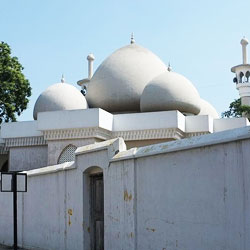
About The Thousand Lights Mosque The Thousand Lights Mosque, located in Chennai, is one of the oldest and most prominent mosques in South India. The mosque gets its name from the countless oil lamps that used to illuminate its prayer hall in the past. It is a significant landmark in the city and holds great historical and architectural importance. The mosque is known for its grand structure, intricate design, and serene ambiance. It attracts worshippers and tourists alike who come to admire its beauty and learn about its rich history. The Thousand Lights Mosque holds a special place in the hearts of the Muslim community in Chennai and is a symbol of unity and spirituality. Architecture of Thousand Lights Mosque The architecture of the Thousand Lights Mosque is a beautiful blend of various styles, including traditional Islamic and Dravidian influences. The mosque features stunning domes, minarets, and intricate carvings that showcase the skill and craftsmanship of the artisans who built it. The main prayer hall of the mosque is spacious and can accommodate a large number of worshippers. The hall is adorned with exquisite Persian rugs, chandeliers, and calligraphy that add to its charm and beauty. The courtyard of the mosque is peaceful and well-maintained, providing a serene space for reflection and prayer. History The Thousand Lights Mosque has a rich history that dates back to the early 19th century. It was constructed by the Wallajah family, the rulers of the Carnatic region, as a place of worship for the Muslim community in Chennai. The mosque has stood the test of time and has witnessed many significant events throughout its existence. Over the years, the Thousand Lights Mosque has played a crucial role in promoting harmony and tolerance among people of different faiths. It has become a symbol of unity and peace in a city known for its cultural diversity. Best Time To Visit The best time to visit the Thousand Lights Mosque is during the early morning or late afternoon when the weather is pleasant, and the sunlight enhances the beauty of the architecture. The mosque is open to visitors throughout the day, but it is recommended to avoid visiting during prayer times to respect the worshippers. Visiting the mosque during special occasions or festivals is also a great way to experience the vibrant atmosphere and traditional customs of the local community. It is advisable to check the timings and any restrictions before planning your visit to the Thousand Lights Mosque. How To Reach The Thousand Lights Mosque is located in Anna Salai, one of the main thoroughfares in Chennai, making it easily accessible by various modes of transportation. The mosque is well-connected by road, and visitors can reach it by bus, taxi, or auto-rickshaw from different parts of the city. For those traveling by train, the nearest railway station is Chennai Central, which is just a short distance away from the mosque. Tourists coming from other cities can also reach Chennai by air and then take a cab or public transport to reach the Thousand Lights Mosque. Visitor Tips When visiting the Thousand Lights Mosque, it is important to dress modestly and respect the customs and traditions of the Muslim community. Both men and women are required to cover their shoulders and legs before entering the mosque. It is advisable to remove your shoes before entering the prayer hall and maintain silence and decorum during your visit. Photography is usually not allowed inside the mosque, so it is best to ask for permission before taking any pictures. Visitors are also encouraged to interact with the locals and learn more about the history and significance of the Thousand Lights Mosque. Shopping for souvenirs or local handicrafts in the nearby markets is a great way to support the community and take home a piece of Chennai's vibrant culture.
Explore More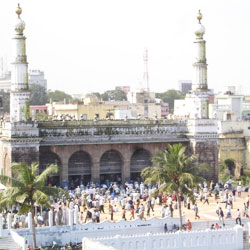
About The Big Mosque The Big Mosque, also known as Wallajah Mosque, is one of the oldest mosques in Chennai, India. It holds great historical and architectural significance, attracting visitors from all over the world. The mosque is located in the Triplicane area of Chennai and is a symbol of religious harmony and peace. Architecture of Big Mosque The Big Mosque is a stunning example of Islamic architecture. The mosque features intricate carvings, beautiful domes, and minarets that soar into the sky. The main prayer hall is spacious and adorned with colorful tiles and intricate patterns. The courtyard of the mosque is serene and provides a peaceful place for worshippers to gather and pray. The architectural beauty of the Big Mosque is a testament to the craftsmanship and skill of the artisans who built it. History The Big Mosque was constructed in the 18th century by the Wallajah family, who were the Nawabs of the Carnatic region. The mosque was built to serve as a place of worship for the Muslim community in Chennai. Over the years, the mosque has undergone renovations and restorations to preserve its historical significance. Today, the mosque stands as a symbol of the rich cultural heritage of Chennai. Best Time To Visit The best time to visit the Big Mosque is during the holy month of Ramadan. During this time, the mosque comes alive with prayers, community gatherings, and festivities. Visitors can experience the vibrant atmosphere of the mosque and witness the traditions and customs of the Muslim community. Additionally, the Big Mosque is open to visitors throughout the year, so any time is a good time to explore this architectural marvel. How To Reach The Big Mosque is easily accessible by public transportation. Visitors can take a bus or taxi to the Triplicane area of Chennai, where the mosque is located. The nearest railway station is the Chennai Central Station, which is a short distance away from the mosque. From there, visitors can hire a taxi or auto-rickshaw to reach the Big Mosque. The mosque is also located near several hotels and restaurants, making it a convenient destination for tourists. Visitor Tips When visiting the Big Mosque, it is important to dress modestly and respect the customs and traditions of the Muslim community. Women are required to cover their heads with a scarf or shawl while inside the mosque. Visitors are also encouraged to remove their shoes before entering the prayer hall. Additionally, it is recommended to visit the mosque during non-prayer times to avoid disrupting the worshippers. Lastly, visitors should explore the surrounding area of Triplicane, which is known for its vibrant markets and street food stalls.
Explore More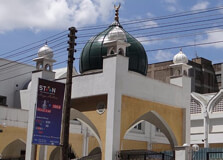
About The Jamia Mosque The Jamia Mosque, located in Nairobi, Kenya, is one of the most prominent Islamic landmarks in the country. It is a significant place of worship for the Muslim community in Nairobi and serves as a center for religious and cultural activities. The mosque is known for its impressive architecture, rich history, and strong community presence. Architecture of Jamia Mosque The Jamia Mosque features a blend of traditional Islamic and modern architectural styles. The mosque's exterior is adorned with intricate carvings and decorative elements, while the interior boasts stunning geometric patterns and colorful stained glass windows. The main prayer hall is spacious and can accommodate a large number of worshippers, with a beautiful mihrab (prayer niche) facing towards Mecca. History The Jamia Mosque was established in 1902 by Muslim traders and settlers in Nairobi. Over the years, it has undergone several renovations and expansions to accommodate the growing Muslim population in the city. The mosque has played a significant role in promoting Islamic education, community development, and interfaith dialogue in Nairobi. Best Time To Visit The best time to visit the Jamia Mosque is during the holy month of Ramadan, when the mosque is bustling with worshippers attending daily prayers and special religious events. Visitors can also experience the vibrant atmosphere of Eid al-Fitr and Eid al-Adha celebrations, which attract large crowds to the mosque. How To Reach The Jamia Mosque is located in the heart of Nairobi, making it easily accessible by public transportation or car. Visitors can take a matatu (minibus), taxi, or ride-sharing service to reach the mosque. The mosque is situated near major landmarks such as Kenyatta International Conference Center and City Market, making it a convenient stop for tourists exploring the city. Visitor Tips - Respect the mosque's dress code by wearing modest clothing that covers your shoulders and knees. - Remove your shoes before entering the mosque and follow the direction of prayer when inside. - Avoid visiting during prayer times unless you plan to join the congregation in prayer. - Ask for permission before taking photographs inside the mosque, as some areas may be off-limits. - Take the time to learn about the mosque's history and significance in the local Muslim community by joining a guided tour or attending a cultural event.
Explore More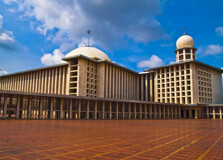
The Istiqlal Mosque, located in Jakarta, Indonesia, is the largest mosque in Southeast Asia and the national mosque of Indonesia. Its name, Istiqlal, means "independence" in Arabic, symbolizing Indonesia's struggle for independence from Dutch colonization. The mosque was designed by Frederich Silaban, a Christian architect, and was inaugurated in 1978 by Indonesia's second president, Soeharto. Architecture of Istiqlal Mosque The architecture of the Istiqlal Mosque is a blend of modern and traditional styles, with a large dome at the center and a minaret on each side. The mosque can accommodate over 120,000 worshippers and features a spacious prayer hall, ablution fountains, and Islamic calligraphy adorning the walls. The interior is decorated with marble and stained glass windows, creating a serene and contemplative atmosphere for prayer and reflection. History The construction of the Istiqlal Mosque was initiated in 1961 by Indonesia's first president, Sukarno, as a symbol of national pride and unity. The mosque was built to commemorate Indonesia's independence from Dutch rule and to provide a place of worship for the growing Muslim population in Jakarta. The project faced challenges due to lack of funding and political turmoil, but it was eventually completed and inaugurated in 1978. Best Time To Visit The best time to visit the Istiqlal Mosque is during the holy month of Ramadan, when the mosque is filled with worshippers and special prayers and events are held to mark the occasion. Visitors can experience the vibrant atmosphere of Ramadan, participate in iftar (breaking the fast) gatherings, and witness the devoutness of the Muslim community. It is also recommended to visit the mosque during weekdays to avoid the crowds that gather on weekends. How To Reach The Istiqlal Mosque is located in central Jakarta, near Merdeka Square and the Jakarta Cathedral. Visitors can reach the mosque by various means of transportation, including public buses, taxis, and online ride-hailing services. The mosque is easily accessible from different parts of the city, and there are designated parking areas for those who prefer to drive. It is advisable to check the traffic conditions in advance to plan your visit accordingly. Visitor Tips 1. Dress modestly when visiting the Istiqlal Mosque, covering your arms and legs out of respect for the Muslim tradition. 2. Remove your shoes before entering the mosque and make sure to maintain silence and respect during prayers. 3. Take the time to explore the mosque's architecture and design, as well as the beautiful views of Jakarta from the top of the minarets. 4. Visit the mosque in the early morning or late afternoon to avoid the heat and humidity of Jakarta's tropical climate. 5. Consider joining a guided tour of the mosque to learn more about its history, significance, and cultural importance.
Explore More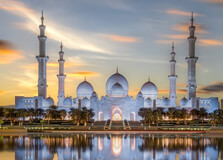
Sheikh Zayed Grand Mosque Center
The Sheikh Zayed Grand Mosque Center, located in Abu Dhabi, is one of the largest and most magnificent mosques in the world. Named after the late Sheikh Zayed bin Sultan Al Nahyan, the founding father and first president of the United Arab Emirates, the mosque serves as a key place of worship and a cultural landmark in the region. The mosque's design reflects a fusion of various Islamic architectural styles, incorporating elements from Morocco, Pakistan, Turkey, and Egypt. Architecture of Sheikh Zayed Grand Mosque Center The architecture of the Sheikh Zayed Grand Mosque Center is a stunning masterpiece that showcases the beauty and grandeur of Islamic design. The mosque features white marble exteriors adorned with intricate floral patterns and verses from the Quran inlaid with semi-precious stones. The main prayer hall is dominated by one of the world's largest handmade carpets, and the seven crystal chandeliers made by Faustig of Munich are a sight to behold. The mosque's minarets reach a height of over 100 meters, adding to its majestic presence. History The construction of the Sheikh Zayed Grand Mosque Center began in 1996 and was completed in 2007. It was built to embody the cultural diversity and Islamic heritage of the United Arab Emirates, serving as a place of worship and a center for Islamic teachings. The mosque stands as a tribute to Sheikh Zayed's vision of promoting tolerance, coexistence, and cultural dialogue in the region. Best Time To Visit The best time to visit the Sheikh Zayed Grand Mosque Center is during the cooler months of October to April when the weather is more pleasant for outdoor exploration. The mosque is particularly enchanting at sunset when the lights illuminate its grand facades, creating a magical ambiance. However, visitors should be mindful of prayer times as the mosque may be closed to non-worshippers during these periods. How To Reach The Sheikh Zayed Grand Mosque Center is easily accessible by car, taxi, or public transportation from Abu Dhabi city center. Visitors can also opt for guided tours that include transportation to and from the mosque. If driving, ample parking spaces are available on-site for visitors. The mosque is approximately a 20-minute drive from Abu Dhabi International Airport, making it convenient for travelers arriving by air. Visitor Tips When visiting the Sheikh Zayed Grand Mosque Center, it is important to dress modestly and respect the mosque's customs. Both men and women are required to wear appropriate attire covering their shoulders, arms, and legs. Women must also cover their heads with a scarf. Visitors should remove their shoes before entering the mosque and maintain a quiet demeanor while inside. Photography is allowed but should be done discreetly and without disturbing worshippers. Guided tours are available for those interested in learning more about the mosque's history and significance.
Explore More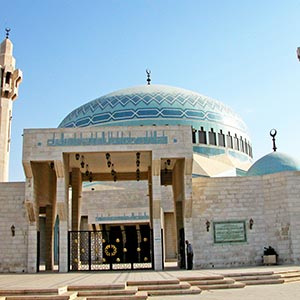
The King Abdullah Mosque, located in Amman, Jordan, is one of the most iconic and impressive landmarks in the city. Named after the late King Abdullah I, the mosque is a symbol of the country's rich history and culture. The mosque serves as a place of worship for Muslims in the area and also attracts tourists from all around the world who come to admire its stunning architecture and serene atmosphere. Architecture of King Abdullah Mosque The King Abdullah Mosque is a masterpiece of Islamic architecture, blending modern and traditional elements seamlessly. The mosque's design features a large dome at its center, surrounded by four minarets that reach towards the sky. The exterior is adorned with intricate geometric patterns and calligraphy, while the interior is decorated with beautiful mosaics and ornate chandeliers. The overall design of the mosque reflects the rich cultural heritage of Jordan and is a sight to behold for visitors. History The King Abdullah Mosque was completed in 1989 and was named in honor of King Abdullah I, the founder of modern Jordan. The construction of the mosque was part of a larger project to enhance the city's infrastructure and promote Islamic culture in the region. Since its completion, the mosque has become a symbol of religious tolerance and unity in Jordan, welcoming visitors from all walks of life to experience its beauty and tranquility. Best Time To Visit The best time to visit the King Abdullah Mosque is during the early morning or late afternoon when the sun is not too harsh and the crowds are smaller. The mosque is open to visitors throughout the day, but it is advisable to check the prayer times in advance to avoid any disruptions. The cooler months of spring and fall are also ideal times to visit, as the weather in Amman is more pleasant during these seasons. How To Reach The King Abdullah Mosque is located in the heart of Amman, making it easily accessible by public transportation or taxi. Visitors can take a bus or taxi to the mosque from various points in the city, or they can choose to walk if they are staying nearby. The mosque is also conveniently located near other popular attractions in Amman, making it a convenient stop for tourists exploring the city. Visitor Tips When visiting the King Abdullah Mosque, it is important to dress modestly out of respect for the religious significance of the site. Both men and women should wear clothing that covers their arms and legs, and women are encouraged to cover their heads with a scarf. Visitors should also remove their shoes before entering the mosque and be mindful of the prayer times to avoid disrupting worshippers. Additionally, photography is allowed outside the mosque but is prohibited inside, so visitors should be respectful of the rules and guidelines while exploring this beautiful and sacred place.
Explore More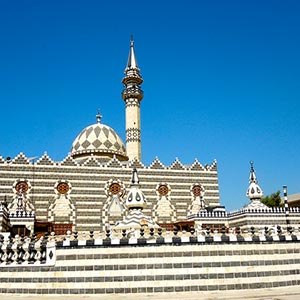
The Abu Darwish Mosque, located in Amman, Jordan, is an iconic landmark that holds cultural and historical significance in the region. Its distinctive blue dome and white facade make it a landmark that stands out in the city skyline. The mosque is a beautiful example of Islamic architecture and is a popular destination for visitors looking to explore the history and culture of Jordan. Architecture of Abu Darwish Mosque The Abu Darwish Mosque features a unique blend of architectural styles, combining traditional Islamic design elements with influences from the Ottoman era. The mosque's most striking feature is its large blue dome, which is a common feature in many mosques in the region. The white walls of the mosque are adorned with intricate geometric patterns and calligraphy, showcasing the craftsmanship and attention to detail that went into its construction. History The Abu Darwish Mosque was built in 1961 on the site of an ancient mosque dating back to the early 20th century. The mosque is named after Abu Darwish, a famous local sheikh who was known for his piety and wisdom. Throughout its history, the mosque has served as a place of worship and community gathering for the residents of Amman. Best Time To Visit The best time to visit the Abu Darwish Mosque is during the early morning or late afternoon when the weather is cooler, and the light is perfect for capturing the beauty of the mosque's architecture. Visiting during the holy month of Ramadan is also a unique experience, as the mosque comes alive with worshippers and festivities during this time. How To Reach The Abu Darwish Mosque is located in the heart of Amman, making it easily accessible by public transportation. Visitors can take a taxi or bus to reach the mosque, or opt for a guided tour that includes a visit to this iconic landmark. The mosque is also within walking distance of the Roman Theatre and other popular attractions in the city. Visitor Tips When visiting the Abu Darwish Mosque, it is important to dress modestly and respectfully, covering shoulders and knees. Visitors should also remove their shoes before entering the mosque and follow any guidelines provided by mosque staff. Photography is allowed outside the mosque, but not inside the prayer hall. It is also recommended to visit the mosque during non-prayer times to avoid disrupting worshippers. Lastly, visitors should take the time to appreciate the peaceful atmosphere and stunning architecture of this historic landmark.
Explore More
The Tomb of Minh Mang is a majestic burial site located in Hue, Vietnam. It was built in the early 19th century as the final resting place for Emperor Minh Mang, the second ruler of the Nguyen Dynasty. The tomb is set amidst lush gardens and tranquil surroundings, reflecting the emperor's respect for nature and his Confucian beliefs. Architecture of Tomb of Minh Mang The architecture of the Tomb of Minh Mang is a harmonious blend of traditional Vietnamese and Chinese styles. The main entrance is marked by a grand gate, leading to a courtyard with statues of warriors and mandarins. Beyond the courtyard lies the Stele Pavilion, where a massive stone tablet inscribed with the emperor's accomplishments is housed. The tomb itself is situated on a hill, overlooking a serene lake and surrounded by pavilions and temples. History Emperor Minh Mang ruled Vietnam from 1820 to 1841 and was known for his strict Confucian principles and dedication to administrative reforms. After his death, his son, Emperor Thieu Tri, commissioned the construction of the tomb as a tribute to his father's legacy. The construction of the Tomb of Minh Mang was completed in 1843, two years after the emperor's death. Best Time To Visit The best time to visit the Tomb of Minh Mang is during the dry season, which falls between March and August. The weather is pleasant, and the gardens are in full bloom, making it an ideal time to explore the tomb's grounds. Avoid visiting during the rainy season, as the grounds can become muddy and slippery, making it difficult to navigate. How To Reach The Tomb of Minh Mang is located about 12 kilometers outside of Hue City, making it easily accessible by car or motorbike. Visitors can also opt to take a taxi or join a guided tour from the city center. The journey to the tomb is scenic, with lush countryside and rice paddies along the way. Visitor Tips 1. Wear comfortable shoes as there is a fair amount of walking involved within the tomb complex. 2. Bring a hat and sunscreen to protect yourself from the sun, as there is limited shade in certain areas. 3. Respect the sanctity of the tomb and follow the rules and regulations set by the authorities. 4. Take your time to explore the different structures and enjoy the peaceful surroundings of the tomb. 5. Visit early in the morning or late in the afternoon to avoid crowds and have a more serene experience.
Explore More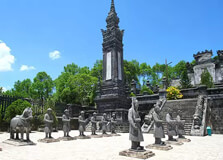
The Royal Tombs in Hue, Vietnam, are a collection of tombs and mausoleums built for emperors of the Nguyen Dynasty. These grand burial sites are known for their impressive architecture, intricate designs, and beautiful landscapes. Each tomb reflects the personality and style of the emperor it was built for, making them unique and culturally significant. Architecture of Royal Tombs The Royal Tombs of Hue showcase a blend of traditional Vietnamese architecture and imperial design elements. Each tomb complex typically consists of several structures, including a main tomb, temple, pavilion, and gardens. The buildings are adorned with intricate carvings, colorful mosaics, and elaborate decorations that symbolize the emperor's status and power. The harmonious layout of the tombs reflects the Confucian principles of balance and order, creating a peaceful and majestic atmosphere. History The construction of the Royal Tombs began in the early 19th century and continued until the early 20th century. The Nguyen emperors believed in the importance of honoring their ancestors and ensuring a peaceful afterlife, which led to the creation of these elaborate burial sites. Over the years, the tombs have undergone restoration and preservation efforts to protect their historical and cultural significance. Best Time To Visit The best time to visit the Royal Tombs in Hue is during the dry season, which typically runs from March to August. The weather is warm and sunny, making it ideal for exploring the outdoor tombs and lush gardens. It is also recommended to visit early in the morning or late in the afternoon to avoid crowds and experience the tombs in a more peaceful setting. How To Reach The Royal Tombs in Hue are located just outside the city center and can be easily reached by taxi, motorbike, or guided tour. Visitors can also rent a bicycle or take a boat along the Perfume River to reach the tombs. The entrance fees vary for each tomb, so it is recommended to plan ahead and purchase tickets in advance. Visitor Tips 1. Wear comfortable shoes and clothing as the tombs require a fair amount of walking and exploring. 2. Bring plenty of water and sunscreen, especially during the hot summer months. 3. Respect the sacred nature of the tombs by refraining from loud noises and inappropriate behavior. 4. Hire a local guide to learn more about the history and significance of each tomb. 5. Take your time to fully appreciate the beauty and serenity of the Royal Tombs in Hue. By following these tips and guidelines, visitors can have a memorable and enriching experience exploring the Royal Tombs in Hue, Vietnam.
Explore More
About The Jama Masjid The Jama Masjid in Agra is a beautiful mosque that was built by Shah Jahan, the Mughal emperor known for constructing the iconic Taj Mahal. Completed in 1648, this grand mosque is one of the largest in India and is a significant symbol of Mughal architecture. It is said that the Jama Masjid was built to serve as a congregational mosque for the emperor and his courtiers. Architecture of Jama Masjid The Jama Masjid showcases stunning Mughal architecture with its red sandstone exterior and intricate white marble detailing. The mosque has three large domes, four minarets, and a spacious courtyard that can accommodate thousands of worshipers. The interior is adorned with exquisite carvings, calligraphy, and geometric patterns that reflect the skills of Mughal artisans. History The Jama Masjid has a rich history that dates back to the Mughal era. It was constructed during the reign of Shah Jahan, who was known for his love of grand architectural projects. The mosque was built to symbolize the emperor's power and to provide a place of worship for the Muslim community in Agra. Over the years, the Jama Masjid has stood as a testament to the Mughal dynasty's architectural prowess and cultural influence. Best Time To Visit The best time to visit the Jama Masjid in Agra is during the early morning or late afternoon when the weather is pleasant and the light is perfect for capturing the beauty of the mosque. It is advisable to avoid visiting during peak hours or on Fridays, as the mosque can get crowded with worshipers. How To Reach The Jama Masjid is located in the heart of Agra and is easily accessible by various modes of transportation. Visitors can take a taxi, auto-rickshaw, or cycle rickshaw to reach the mosque from any part of the city. The nearest railway station is Agra Cantt, which is well-connected to major cities in India. The nearest airport is Agra Airport, which has flights to and from Delhi, Mumbai, and other major cities. Visitor Tips When visiting the Jama Masjid, it is important to dress modestly and cover your head before entering the mosque. It is also advisable to remove your shoes before stepping onto the marble floors. Photography is allowed inside the mosque, but it is recommended to be respectful of worshipers and the sanctity of the space. Lastly, be cautious of touts and vendors outside the mosque who may try to sell you souvenirs or services. Overall, the Jama Masjid in Agra is a must-visit destination for those interested in Mughal architecture and history. Its grandeur and beauty make it a significant landmark in the city, and a visit to this majestic mosque is sure to leave a lasting impression on any traveler.
Explore More
About The Rani Rupmati's Mosque Rani Rupmati's Mosque is a historical and architectural gem located in the city of Ahmedabad, Gujarat. It is a beautiful example of Islamic architecture and is considered to be one of the most significant mosques in the region. The mosque is named after Rani Rupmati, the queen of Sultan Mahmud Begada, who ruled in the 15th century. Architecture of Rani Rupmati's Mosque The mosque features a stunning blend of Hindu and Islamic architectural styles, with intricate carvings, delicate designs, and beautiful domes. The mosque is known for its grand entrance, large courtyard, and impressive minarets. The prayer hall is adorned with elegant pillars and arches, creating a serene and spiritual atmosphere. The intricate details and ornate patterns on the walls and ceilings are a testament to the skilled craftsmanship of the artisans of that era. History Rani Rupmati's Mosque was built in the 15th century during the reign of Sultan Mahmud Begada. It was constructed to serve as a place of worship for the Muslim community in the city. The mosque has stood the test of time and has been preserved as a symbol of the rich cultural and architectural heritage of Ahmedabad. Best Time To Visit The best time to visit Rani Rupmati's Mosque is during the cooler months of October to March when the weather is pleasant and ideal for exploring the city. The early morning or late afternoon hours are recommended for a visit to avoid the crowds and to enjoy the peaceful ambiance of the mosque. How To Reach Rani Rupmati's Mosque is located in the heart of Ahmedabad and is easily accessible by various means of transportation. Visitors can reach the mosque by taking a taxi, auto-rickshaw, or public bus from any part of the city. The nearest railway station is Ahmedabad Junction, which is well-connected to major cities in India. Visitor Tips When visiting Rani Rupmati's Mosque, it is advisable to dress modestly and respectfully, covering your shoulders and legs. Visitors are required to remove their shoes before entering the mosque, so it is recommended to wear easy-to-remove footwear. It is also important to maintain silence and respect the sanctity of the place while inside the mosque. Photography is allowed but it is advisable to seek permission from the authorities before taking pictures. Overall, Rani Rupmati's Mosque is a must-visit destination for history buffs, architecture enthusiasts, and spiritual seekers alike. Its majestic beauty and historical significance make it a unique and memorable experience for visitors to Ahmedabad.
Explore More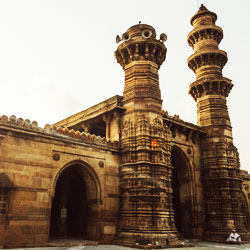
Siddi Bashir Mosque (Shaking Minarets)
About The Siddi Bashir Mosque (Shaking Minarets) The Siddi Bashir Mosque, also known as the Shaking Minarets, is a historical mosque located in Ahmedabad, Gujarat, India. This unique mosque is famous for its two minarets that are connected by a series of intricately carved stone balconies. When one minaret is shaken, the other minaret vibrates as well, hence the name "Shaking Minarets". The reason behind this architectural marvel is still a mystery to engineers and historians. Architecture of Siddi Bashir Mosque (Shaking Minarets) The Siddi Bashir Mosque showcases stunning Indo-Islamic architecture with intricate carvings, delicate designs, and traditional Islamic arches. The main highlight of the mosque is the two minarets that are 21.34 meters tall and are connected by a balcony. The balconies are supported by delicately carved stone brackets without any support from the main building. The minarets are made of sandstone and have beautiful geometric patterns carved into them. History The Siddi Bashir Mosque was built in the early 15th century by Siddi Bashir, a slave of Sultan Ahmed Shah. The mosque was constructed during the reign of the Gujarat Sultanate. The minarets were designed in a way that if one minaret is shaken, the other minaret vibrates as well. The reason behind this unique architecture is still a mystery that baffles engineers and historians. Best Time To Visit The best time to visit the Siddi Bashir Mosque is during the winter months from October to March when the weather is pleasant and conducive to exploring the outdoors. Avoid visiting during the scorching summer months as temperatures can soar above 40 degrees Celsius. How To Reach The Siddi Bashir Mosque is located in the heart of Ahmedabad, making it easily accessible by various modes of transportation. The closest railway station is Ahmedabad Junction, which is well-connected to major cities in India. Local buses and taxis are also available for reaching the mosque from different parts of the city. Visitor Tips 1. Make sure to visit the mosque early in the morning or late in the evening to avoid the crowds and the heat. 2. Respect the religious sentiments of the locals and adhere to the dress code when visiting the mosque. 3. Do not shake the minarets yourself as it can damage the delicate structure and is not allowed by the authorities. 4. Take your time to admire the intricate carvings and architectural details of the mosque, as each corner holds a piece of history. 5. Carry water and wear comfortable shoes as you may need to climb stairs to reach the balconies of the minarets. In conclusion, the Siddi Bashir Mosque (Shaking Minarets) is a fascinating architectural marvel that attracts visitors from all over the world. With its unique design, intricate carvings, and mysterious shaking minarets, this historical mosque is a must-visit destination for anyone interested in history and architecture.
Explore More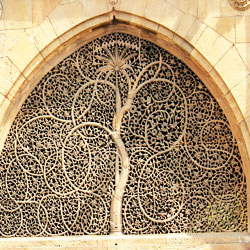
About The Sidi Sayed Jhali The Sidi Sayed Jhali is a famous mosque located in Ahmedabad, India. It is renowned for its intricately carved stone latticework windows, known as jalis. The mosque was built in 1573 by Sidi Sayed, a slave of the Sultan of Gujarat. The jalis at the mosque are considered to be masterpieces of intricate craftsmanship and are a fine example of Indo-Islamic architecture. Architecture of Sidi Sayed Jhali The highlight of Sidi Sayed Jhali is its beautifully carved stone jalis. The jalis depict intertwining branches, foliage, and tree motifs, creating a mesmerizing play of light and shadow. The intricate carvings showcase the skill and craftsmanship of the artisans of that era. The mosque also features stunning arches, domes, and minarets, all typical elements of Indo-Islamic architecture. History The Sidi Sayed Jhali was built in 1573 during the reign of the Sultan of Gujarat. It was constructed by Sidi Sayed, a slave who rose to prominence and was given the opportunity to build this magnificent mosque. The jalis at the mosque are said to have been inspired by the carvings of the Jhulta Minar in Delhi, showcasing the influence of Mughal architecture on the design. Best Time To Visit The best time to visit Sidi Sayed Jhali is during the winter months from November to February when the weather is pleasant and suitable for sightseeing. The cool temperatures make it ideal for exploring the intricate carvings of the jalis without feeling too hot or uncomfortable. Avoid visiting during the summer months as the temperatures can soar, making it difficult to enjoy the outdoor architecture. How To Reach Sidi Sayed Jhali is located in the heart of Ahmedabad, making it easily accessible by various modes of transportation. The nearest airport is Sardar Vallabhbhai Patel International Airport, which is well connected to major cities in India. The mosque is also easily reachable by train, with Ahmedabad Junction being the nearest railway station. Local buses and auto-rickshaws are available for those traveling within the city. Visitor Tips Here are some tips for visitors planning to explore Sidi Sayed Jhali: Wear comfortable footwear as you will need to remove your shoes before entering the mosque. Respect the religious customs and traditions of the mosque, such as dressing modestly and maintaining silence. Visit early in the morning or late in the evening to avoid crowds and experience the peace and tranquility of the mosque. Take your time to admire the intricate carvings of the jalis and the architectural details of the mosque. Carry a camera to capture the stunning beauty of the mosque and its surroundings, but be mindful of not disturbing other visitors. By following these tips, visitors can make the most of their visit to Sidi Sayed Jhali and appreciate the architectural and historical significance of this magnificent mosque.
Explore More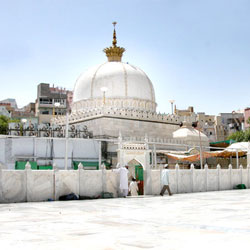
Khwaja Moinuddin Chistis Dargah
About The Khwaja Moinuddin Chistis Dargah The Khwaja Moinuddin Chishti Dargah is one of the most revered Sufi shrines in India, located in the city of Ajmer, Rajasthan. It is the final resting place of the Sufi saint Khwaja Moinuddin Chishti, who is also known as Gharib Nawaz, meaning "Benefactor of the Poor". The Dargah is visited by millions of pilgrims every year, regardless of their religion, to seek blessings and fulfill their wishes. Architecture of Khwaja Moinuddin Chistis Dargah The architecture of the Khwaja Moinuddin Chishti Dargah is a beautiful blend of Mughal and Rajput styles. The main entrance, known as the Nizam Gate, leads to a courtyard with the tomb of the saint in the center. The tomb is made of marble and is adorned with intricate carvings and precious stones. The Dargah also has a mosque, a large courtyard for prayers, and a separate section for women. History The Khwaja Moinuddin Chishti Dargah was built in the 13th century by Sultan Iltutmish of Delhi. Khwaja Moinuddin Chishti was a Sufi saint who traveled to India from Persia and settled in Ajmer. He was known for his teachings of peace, love, and unity among all religions. The Dargah has since become a symbol of harmony and spirituality for people of all faiths. Best Time To Visit The best time to visit the Khwaja Moinuddin Chishti Dargah is during the annual Urs festival, which commemorates the death anniversary of the saint. The Urs festival takes place in the Islamic month of Rajab and attracts pilgrims from across the country. The Dargah is also crowded during other Islamic festivals like Eid and Ramadan. How To Reach The Khwaja Moinuddin Chishti Dargah is located in the heart of Ajmer city, making it easily accessible by road, rail, and air. The nearest airport is in Jaipur, which is around 135 km away. Ajmer also has a well-connected railway station, with trains from major cities like Delhi, Mumbai, and Jaipur. Local buses and taxis are available for transportation within the city. Visitor Tips 1. Dress modestly and respectfully when visiting the Dargah, covering your head and removing your shoes before entering the shrine. 2. Photography is not allowed inside the Dargah premises, so be mindful of this restriction. 3. Make sure to respect the customs and traditions of the Dargah, such as offering prayers and tying threads on the marble screens. 4. Be cautious of touts and beggars outside the Dargah who may try to exploit your generosity. 5. Visit early in the morning or late in the evening to avoid the crowds and experience the peaceful atmosphere of the Dargah.
Explore More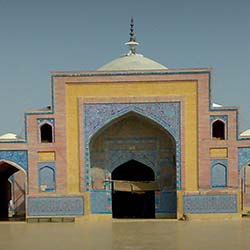
About The Shah Jahan's Mosque The Shah Jahan's Mosque, located in Ajmer, Rajasthan, is a beautiful architectural marvel built by Mughal emperor Shah Jahan in the 17th century. This mosque holds significant historical and cultural importance in India and is a popular tourist attraction for visitors from all over the world. Architecture of Shah Jahan's Mosque The Shah Jahan's Mosque boasts stunning Mughal architecture with intricate carvings and delicate designs. The mosque features white marble domes, finely crafted minarets, and elegant archways that showcase the grandeur of Mughal craftsmanship. The main prayer hall is adorned with exquisite floral patterns and calligraphy, creating a serene and spiritual atmosphere for worshippers. History The Shah Jahan's Mosque was commissioned by Emperor Shah Jahan in 1638 during his visit to Ajmer. It was constructed in honor of his beloved wife, Mumtaz Mahal, who is buried nearby in the famous Ajmer Sharif Dargah. The mosque stands as a symbol of the Mughal Empire's architectural legacy and their influence on Indian culture and society. Best Time To Visit The best time to visit the Shah Jahan's Mosque is during the cooler months of October to March when the weather is pleasant and ideal for exploring the historical sites in Ajmer. Avoid visiting during the summer months as the temperature can soar, making it uncomfortable for sightseeing. How To Reach The Shah Jahan's Mosque is easily accessible by road, rail, and air. The nearest railway station is Ajmer Junction, which is well-connected to major cities in India. The mosque is also conveniently located near the Ajmer Bus Stand, making it accessible by public transportation. If traveling by air, the nearest airport is Jaipur International Airport, which is approximately 135 kilometers away from Ajmer. Visitor Tips 1. Respect the religious significance of the mosque and dress modestly when visiting. 2. Remove your shoes before entering the mosque to show respect for the sacred space. 3. Take time to admire the intricate details of the architecture and immerse yourself in the historical ambiance of the mosque. 4. Visit during prayer times to experience the spiritual atmosphere and witness the local community in worship. 5. Hire a guide to learn more about the history and significance of the Shah Jahan's Mosque for a more enriching experience.
Explore More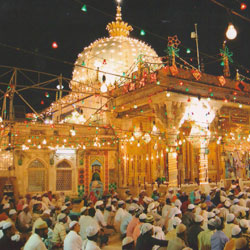
About The Khwaja Garib Nawaz Dargah The Khwaja Garib Nawaz Dargah, located in Ajmer, Rajasthan, is one of the most important Sufi shrines in India. It is dedicated to Khwaja Moinuddin Chishti, a 13th-century Sufi saint who is also known as Garib Nawaz, which means "benefactor of the poor." The Dargah is a place of pilgrimage for Muslims from all over the world, as well as people of other faiths who come to seek blessings and offer prayers. Architecture of Khwaja Garib Nawaz Dargah The Dargah complex is built in a traditional Mughal architectural style, with white marble buildings adorned with intricate carvings and beautiful domes. The centerpiece of the complex is the tomb of Khwaja Moinuddin Chishti, which is surrounded by a large courtyard where devotees gather to offer prayers and seek blessings. The Dargah also houses several other tombs, mosques, and other structures that date back to different periods in history. History The Khwaja Garib Nawaz Dargah was built in the 13th century after the death of Khwaja Moinuddin Chishti. He was a revered Sufi saint who dedicated his life to helping the poor and promoting peace and harmony among people of different faiths. His teachings and spiritual presence attracted a large following, and after his death, the Dargah was established as a place of pilgrimage for his devotees. Over the centuries, the Dargah has become a symbol of unity and brotherhood, attracting people from all walks of life. Best Time To Visit The best time to visit the Khwaja Garib Nawaz Dargah is during the annual Urs festival, which commemorates the death anniversary of Khwaja Moinuddin Chishti. The festival is held in the seventh month of the Islamic lunar calendar and lasts for six days, attracting millions of pilgrims from around the world. The Dargah is beautifully decorated with lights and flowers during this time, and the atmosphere is filled with devotion and spiritual fervor. How To Reach The Khwaja Garib Nawaz Dargah is located in the heart of Ajmer city, making it easily accessible by road, rail, and air. The nearest airport is in Jaipur, which is about 130 kilometers away from Ajmer. The Ajmer Junction railway station is well-connected to major cities in India, making it convenient for visitors to reach the Dargah by train. Additionally, there are regular bus services from nearby cities to Ajmer, making it easy for pilgrims to travel to the Dargah. Visitor Tips When visiting the Khwaja Garib Nawaz Dargah, it is important to dress modestly and show respect for the religious customs and traditions of the place. Visitors are required to remove their shoes before entering the Dargah complex and maintain a peaceful and reverent demeanor. It is also customary to offer prayers and make a donation at the shrine as a sign of reverence and gratitude. Additionally, travelers should be prepared for large crowds, especially during the Urs festival, and plan their visit accordingly to make the most of their spiritual experience at the Dargah. Overall, the Khwaja Garib Nawaz Dargah is not just a religious site but also a symbol of peace, unity, and brotherhood that welcomes people of all faiths with open arms. Whether you are a devout Muslim seeking blessings or a curious traveler interested in exploring the rich spiritual heritage of India, a visit to this sacred shrine is sure to leave a lasting impression on your heart and soul.
Explore More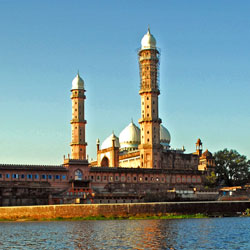
About The Taj-ul-Masjid The Taj-ul-Masjid, located in Bhopal, India, is one of the largest mosques in the country. Its name translates to "Crown of Mosques" and it is a prominent landmark in the city. This grand mosque was built by Nawab Shah Jahan Begum of Bhopal during the late 19th century and is known for its impressive architecture and cultural significance. Architecture of Taj-ul-Masjid The architecture of Taj-ul-Masjid is a blend of Mughal and Islamic styles, with its pink façade, white domes, and towering minarets that add to its grandeur. The mosque boasts a vast courtyard, a large prayer hall, and intricately designed pillars and arches. The impressive central dome is one of the largest in the world, making it a sight to behold for visitors. History The construction of Taj-ul-Masjid began in the 19th century under the reign of Nawab Shah Jahan Begum, but due to financial constraints, the mosque was not completed until the 1970s. Today, it stands as a symbol of Islamic architecture and the rich cultural heritage of Bhopal. Best Time To Visit The best time to visit Taj-ul-Masjid is during the winter months from October to March when the weather is pleasant and conducive for sightseeing. The mosque is open to visitors throughout the year, but it is advisable to avoid visiting during the summer months when temperatures can soar. How To Reach Taj-ul-Masjid is easily accessible by various modes of transportation. The mosque is located in the heart of Bhopal city, making it convenient for visitors to reach. Bhopal has a well-connected network of roads, railways, and airways, with regular buses, trains, and flights to and from major cities in India. Visitor Tips When visiting Taj-ul-Masjid, it is important to dress modestly and respect the customs and traditions of the mosque. Visitors are required to remove their shoes before entering the prayer hall and women are encouraged to cover their heads. Photography is allowed outside the mosque, but it is advisable to seek permission before taking pictures inside. It is also recommended to visit during non-prayer times to avoid disrupting worshippers. In conclusion, Taj-ul-Masjid is not only a place of worship but also a symbol of Bhopal's rich cultural heritage and architectural prowess. Its stunning design and historical significance make it a must-visit destination for tourists and locals alike.
Explore More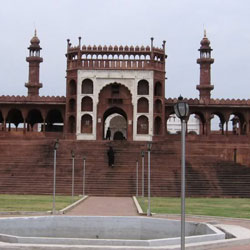
About The Moti Masjid The Moti Masjid, also known as the Pearl Mosque, is a beautiful mosque located in the heart of Bhopal, India. It was built in the 19th century by Sikander Begum, the daughter of Qudsia Begum, in the year 1860. The mosque is an architectural marvel that showcases the rich cultural heritage of the region. Architecture of Moti Masjid The Moti Masjid is made of pristine white marble, which gives it a pearl-like appearance hence its name. The mosque features three stunning domes with intricate carvings and geometric patterns. The facade of the mosque is adorned with delicate designs and calligraphy, adding to its grandeur. The interior of the mosque is equally impressive, with a spacious prayer hall lined with pillars and arches, creating a sense of serenity and tranquility. History The Moti Masjid was commissioned by Sikander Begum, the Sultan of Bhopal, as a place of worship for the royal family. The construction of the mosque was completed in 1860, and it has since served as a significant religious and cultural landmark in the city. Over the years, the Moti Masjid has been well-maintained and preserved, allowing visitors to admire its exquisite architecture and historical significance. Best Time To Visit The best time to visit the Moti Masjid is during the winter months, from October to March, when the weather is pleasant and ideal for sightseeing. The cool temperatures make it comfortable to explore the mosque and appreciate its beauty without the sweltering heat of the summer months. Additionally, visiting in the early morning or late afternoon allows you to avoid the crowds and enjoy a peaceful experience at the mosque. How To Reach The Moti Masjid is located in the heart of Bhopal, making it easily accessible by various modes of transportation. If you are traveling by air, the nearest airport is Raja Bhoj Airport, which is approximately 13 kilometers away from the mosque. You can also reach the mosque by train, as Bhopal Junction is well-connected to major cities in India. For those traveling by road, there are plenty of buses and taxis available to reach the Moti Masjid within the city. Visitor Tips When visiting the Moti Masjid, it is essential to dress modestly and respect the religious customs of the mosque. Make sure to remove your shoes before entering the prayer hall and maintain a quiet and peaceful demeanor while inside. It is also recommended to hire a local guide who can provide you with insights into the history and architecture of the mosque. Lastly, don't forget to bring a camera to capture the stunning beauty of the Moti Masjid and create lasting memories of your visit.
Explore More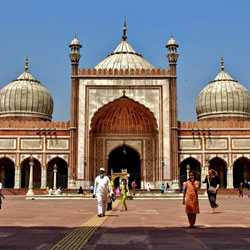
About The Jama Masjid The Jama Masjid in Bhopal is a striking example of Mughal architecture that serves as a significant religious and cultural landmark in the city. Built in 1837 by Qudsia Begum, the first female ruler of Bhopal, the mosque is known for its grandeur and intricate design. It is one of the largest mosques in India and can accommodate thousands of worshippers. Architecture of Jama Masjid The Jama Masjid features a blend of Islamic and Indian architectural styles, with its stunning domes, minarets, and intricate carvings. The main prayer hall is adorned with beautiful marble flooring, ornate pillars, and delicate calligraphy on the walls. The mosque's courtyard is spacious and provides a peaceful setting for worshippers to gather. History The Jama Masjid has a rich history that dates back to the early 19th century. It was commissioned by Qudsia Begum, also known as Gohar Begum, who was the ruler of Bhopal from 1819 to 1837. She was a patron of the arts and culture and wanted to leave behind a lasting legacy in the form of a grand mosque for the people of Bhopal. Best Time To Visit The best time to visit the Jama Masjid in Bhopal is during the cooler months of October to March when the weather is pleasant and ideal for exploring the mosque and its surroundings. Visitors can also witness various religious ceremonies and events that take place at the mosque during this time. How To Reach The Jama Masjid is located in the heart of Bhopal city, making it easily accessible by public transportation. Visitors can take a taxi, auto-rickshaw, or local bus to reach the mosque. The nearest railway station is Bhopal Junction, which is just a short drive away from the mosque. Visitor Tips When visiting the Jama Masjid, it is important to dress modestly and respectfully, covering arms and legs. It is also recommended to remove shoes before entering the mosque. Visitors should be mindful of their behavior and maintain silence while inside the prayer hall to respect the worshippers. Photography may be restricted in certain areas, so it is advisable to ask for permission before taking pictures. Overall, the Jama Masjid in Bhopal is a must-visit destination for history buffs, architecture enthusiasts, and those seeking a spiritual experience in a serene setting. Its grandeur and cultural significance make it a truly remarkable landmark in the city of Bhopal, showcasing the rich heritage and architectural beauty of India.
Explore More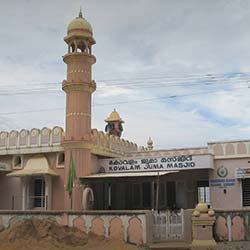
About The Kovalam Jama Masjid The Kovalam Jama Masjid, located in Kovalam, is a historic mosque that serves as a significant religious and cultural landmark in the region. The mosque attracts visitors from all over the world who come to admire its stunning architecture and serene ambiance. The Kovalam Jama Masjid is not only a place of worship but also a symbol of unity and harmony among people of different faiths. Architecture of Kovalam Jama Masjid The Kovalam Jama Masjid features a blend of traditional Kerala and Mughal architectural styles. The mosque is characterized by its elegant domes, intricate carvings, and minarets that soar high into the sky. The interiors of the mosque are adorned with beautiful calligraphy and elaborate designs that create a peaceful and spiritual atmosphere. The courtyard of the mosque is spacious and well-maintained, providing a tranquil space for visitors to relax and reflect. History The Kovalam Jama Masjid has a rich history that dates back several centuries. It was built by early Muslim settlers in the region who arrived for trade and eventually decided to settle down. Over the years, the mosque has undergone several renovations and expansions to accommodate the growing Muslim community in Kovalam. Today, the Kovalam Jama Masjid stands as a symbol of the enduring legacy of Islam in the region. Best Time To Visit The best time to visit the Kovalam Jama Masjid is during the winter months from November to February when the weather is pleasant and ideal for sightseeing. The cool breeze and clear skies make it a perfect time to explore the mosque and its surroundings. It is also advisable to visit the mosque during prayer times to experience the spiritual and cultural practices of the local Muslim community. How To Reach The Kovalam Jama Masjid is easily accessible by road from Kovalam town. Visitors can take a taxi or auto-rickshaw to reach the mosque, which is located in the heart of the town. The mosque is also well-connected by public transport, with buses and trains running regularly to the nearby Kovalam bus stand and railway station. Visitor Tips When visiting the Kovalam Jama Masjid, it is important to dress modestly and respect the customs and traditions of the Muslim community. Visitors are required to remove their shoes before entering the mosque and maintain silence during prayer times. It is also recommended to seek permission before taking photographs inside the mosque and to refrain from any disruptive behavior. Additionally, visitors can explore the local markets and shops surrounding the mosque to experience the vibrant culture and heritage of Kovalam.
Explore More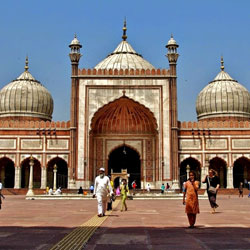
About The Jama Masjid The Jama Masjid in Lucknow is one of the most prominent landmarks in the city and is a significant religious site for Muslims. Built in the 19th century by Sultan Ahmed Shah, the Jama Masjid is a beautiful example of Mughal architecture and is known for its grandeur and historical significance. Architecture of Jama Masjid The Jama Masjid in Lucknow is a stunning blend of Mughal and Persian architectural styles. The mosque is built with red sandstone and features intricate carvings and beautiful domes. The main prayer hall is adorned with delicate marble work, while the courtyard is spacious and peaceful, making it a perfect place for prayer and reflection. The Jama Masjid also has four minarets that add to its grandeur and beauty. History The Jama Masjid was built in 1839 by Sultan Ahmed Shah, the third king of the Awadh region. The mosque was constructed to serve as a central place of worship for the city's Muslim population and has since become a symbol of religious tolerance and harmony in Lucknow. Over the years, the Jama Masjid has stood as a testament to the rich cultural heritage of the region and continues to be a popular destination for both locals and tourists. Best Time To Visit The best time to visit the Jama Masjid in Lucknow is during the early morning or late afternoon when the weather is cooler and the light is perfect for capturing the beauty of the mosque. The mosque is open to visitors throughout the year, but it is recommended to avoid visiting during prayer times to respect the religious practices of the worshippers. How To Reach The Jama Masjid is located in the heart of Lucknow, making it easily accessible by both public and private transportation. Visitors can take a taxi or auto-rickshaw to reach the mosque, or they can opt for local buses that run throughout the city. The mosque is also within walking distance from many hotels and tourist attractions in Lucknow, making it a convenient stop for those exploring the city. Visitor Tips When visiting the Jama Masjid, it is important to dress modestly and respectfully, as it is a religious site. Visitors should also remove their shoes before entering the mosque and avoid taking photographs during prayer times. It is recommended to visit the mosque with a guide who can provide insights into its history and significance. Additionally, visitors should be mindful of the cultural practices and customs of the region and be respectful of the worshippers at the mosque.
Explore More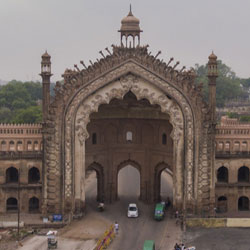
About The Rumi Darwaza The Rumi Darwaza is an iconic historical monument located in Lucknow, Uttar Pradesh, India. It is also known as the Turkish Gate and was built in 1784 by Nawab Asaf-ud-Daula, the fourth Nawab of Awadh. The Rumi Darwaza stands as a symbol of Lucknow's rich cultural heritage and architectural prowess. It is a stunning example of Mughal architecture and is one of the most well-preserved gateways in the country. Architecture of Rumi Darwaza The Rumi Darwaza is an imposing structure that stands at a height of 60 feet. It is made of bricks and lime mortar, and its design draws inspiration from Turkish architecture. The gateway is adorned with intricate floral designs and calligraphy, adding to its grandeur. The Rumi Darwaza has a double-storeyed facade with a large arched opening on the ground floor and smaller arched windows on the upper floor. The gateway is topped with an octagonal chhatri (umbrella-like dome) that adds to its architectural beauty. History The Rumi Darwaza was built during the reign of Nawab Asaf-ud-Daula to provide relief to the famine-stricken population of Lucknow. The gateway was named 'Rumi' which means Roman, as it was believed to be inspired by the Sublime Porte in Constantinople (present-day Istanbul). The construction of the Rumi Darwaza also served as a means to generate employment for the local populace during the period of distress. Over the years, the Rumi Darwaza has witnessed the ebb and flow of history and has stood as a silent witness to the changing times. Best Time To Visit The best time to visit the Rumi Darwaza is during the winter months from October to March when the weather is pleasant and suitable for sightseeing. The cool temperatures make it ideal for exploring the monument and enjoying its architectural splendor. Additionally, visiting early in the morning or late in the evening allows you to avoid the crowds and experience the tranquil beauty of the Rumi Darwaza. It is advisable to check the local weather conditions before planning your visit to ensure a comfortable and enjoyable experience. How To Reach The Rumi Darwaza is located in the heart of Lucknow city and is easily accessible by various modes of transportation. If you are traveling by air, the nearest airport is Chaudhary Charan Singh International Airport, which is approximately 15 kilometers away from the monument. You can hire a taxi or take a local bus to reach the Rumi Darwaza from the airport. If you are traveling by train, Lucknow Junction Railway Station is the nearest railhead, located about 5 kilometers from the gateway. From the railway station, you can hire a cab or take a local bus to reach the Rumi Darwaza. Visitor Tips 1. Photography: Photography is allowed at the Rumi Darwaza, so make sure to capture the beauty of the monument and preserve your memories. 2. Respect the Heritage: While visiting the Rumi Darwaza, it is important to respect the heritage and maintain the cleanliness of the surroundings. Avoid littering and follow the guidelines set by the authorities. 3. Guided Tours: To learn more about the history and architecture of the Rumi Darwaza, consider taking a guided tour with a knowledgeable guide who can provide insights and interesting facts about the monument. 4. Comfortable Footwear: The Rumi Darwaza has a large area to explore, so wear comfortable footwear to make your visit more enjoyable and hassle-free. 5. Local Cuisine: After exploring the Rumi Darwaza, don't forget to savor the local cuisine of Lucknow, known for its delectable dishes such as kebabs, biryanis, and sweets. Visiting the Rumi Darwaza is a journey back in time to experience the grandeur and architectural marvels of the bygone era. The monument stands as a testament to the artistic and cultural legacy of Lucknow, making it a must-visit destination for history buffs and architecture enthusiasts.
Explore More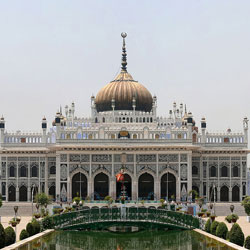
About The Chhota Imambara The Chhota Imambara, also known as Imambara Hussainabad Mubarak, is a popular tourist attraction located in Lucknow, Uttar Pradesh, India. It was built by Mohammed Ali Shah in 1838 as a place for religious gatherings and commemorating events in Shia Islam. The complex includes a mosque, a stepwell, and a stunning garden, making it a must-visit destination for history enthusiasts and architectural aficionados. Architecture of Chhota Imambara The Chhota Imambara is renowned for its exquisite Mughal architecture, featuring intricate designs and beautiful embellishments. The main building is adorned with glistening chandeliers, Belgian mirrors, and exquisite calligraphy. The central hall, also known as Azakhana, is where the religious ceremonies and gatherings take place. The complex also includes a stunning water body known as Satkhanda, which adds to the charm of the overall architecture. History The Chhota Imambara was built by Mohammed Ali Shah, the third Nawab of Awadh, in 1838. The construction of the monument was a way for the Nawab to provide employment to the people during a severe famine that struck the region. The complex served as a place for religious and social gatherings, as well as a mausoleum for the Nawab and his family members. Over the years, the Chhota Imambara has become a symbol of Lucknow's rich cultural heritage. Best Time To Visit The best time to visit the Chhota Imambara is during the winter months, from October to March, when the weather is pleasant and ideal for exploring the monument and its surroundings. The Chhota Imambara is especially beautiful during festivals like Muharram and Eid, when the complex is adorned with lights and decorations, creating a festive atmosphere. How To Reach The Chhota Imambara is easily accessible by road, rail, and air. Lucknow has a well-connected airport, the Chaudhary Charan Singh International Airport, which is approximately 14 km away from the monument. The Lucknow Railway Station is about 4 km from the Chhota Imambara, making it convenient for those traveling by train. Additionally, local buses and taxis are available for commuting within the city. Visitor Tips 1. It is advisable to dress modestly while visiting the Chhota Imambara, as it is a religious site. 2. Photography may be restricted in certain areas of the complex, so it is recommended to inquire before clicking pictures. 3. Be mindful of the cultural and religious significance of the monument and maintain decorum during your visit. 4. Respect the rules and regulations of the monument and avoid littering or causing any damage to the property. 5. Engage with local guides to learn more about the history and architecture of the Chhota Imambara for a comprehensive experience.
Explore More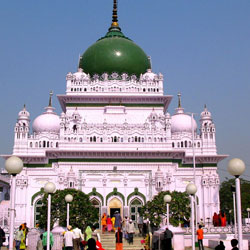
About The Dewa Sharif The Dewa Sharif is a famous shrine located in the city of Lucknow, in the state of Uttar Pradesh, India. It is dedicated to Haji Waris Ali Shah, a Sufi saint who is highly revered by followers of all faiths. The shrine is known for its peaceful and spiritual ambiance, attracting devotees from all over the country. The Dewa Sharif is not just a place of worship, but also a symbol of communal harmony, as people from different religions come together to pay their respects to the saint. Architecture of Dewa Sharif The architecture of Dewa Sharif is a blend of Mughal and Rajput styles, featuring intricate carvings, domes, and minarets. The shrine is adorned with beautiful marble work, colorful mosaic tiles, and exquisite calligraphy that highlight the spiritual significance of the place. The main prayer hall is spacious and decorated with chandeliers and Persian rugs, creating a serene atmosphere for prayer and reflection. History The Dewa Sharif was built in the 19th century in honor of Haji Waris Ali Shah, who was a renowned Sufi saint known for his piety and miracles. The shrine has since become a symbol of peace and unity, attracting thousands of pilgrims and tourists every year. The history of Dewa Sharif is deeply intertwined with the cultural and religious fabric of Lucknow, making it a significant landmark in the city's history. Best Time To Visit The best time to visit Dewa Sharif is during the annual Urs festival, which commemorates the death anniversary of Haji Waris Ali Shah. The Urs festival is a vibrant and colorful event that attracts a large number of devotees and tourists who come to pay their respects and participate in the festivities. The shrine is beautifully decorated with lights and flowers during this time, creating a festive and joyous atmosphere. How To Reach The Dewa Sharif is located about 30 kilometers away from Lucknow city center and is easily accessible by road. Visitors can take a taxi or hire a car to reach the shrine, which is well-connected by a network of roads. The nearest railway station to Dewa Sharif is Barabanki Junction, which is about 10 kilometers away. Lucknow also has an international airport, making it convenient for travelers from around the world to visit the shrine. Visitor Tips 1. Dress modestly when visiting the Dewa Sharif, as it is a place of worship. 2. Remove your shoes before entering the prayer hall and show respect for the customs and traditions of the shrine. 3. Be mindful of your behavior and maintain silence inside the shrine to allow others to pray peacefully. 4. Avoid visiting during peak hours to experience a more peaceful and serene atmosphere. 5. Carry some cash for donations or offerings at the shrine, as it is a common practice among visitors. Visiting the Dewa Sharif in Lucknow is not just a religious pilgrimage but also a cultural experience that showcases the rich heritage and traditions of the region. The shrine's architecture, history, and spiritual significance make it a must-visit destination for anyone exploring the city of Lucknow.
Explore More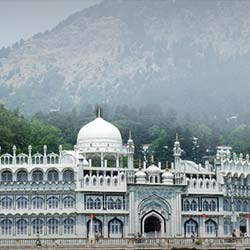
About The Jama Masjid Mosque The Jama Masjid Mosque in Nainital is a prominent Muslim place of worship located in the heart of the city. This beautiful mosque attracts visitors from all walks of life who come to admire its stunning architecture and peaceful surroundings. The mosque serves as a symbol of religious harmony in Nainital, where people of different faiths coexist peacefully. Architecture of Jama Masjid Mosque The Jama Masjid Mosque in Nainital is a fine example of Mughal architecture, with its distinctive domes, minarets, and intricate carvings. The mosque is built using red sandstone, which gives it a regal and majestic appearance. The central courtyard of the mosque is spacious and can accommodate a large number of worshippers during prayer times. The interiors of the mosque are adorned with beautiful calligraphy and traditional Islamic art, creating a serene and spiritual atmosphere. History The Jama Masjid Mosque in Nainital was built in the late 19th century during the British colonial era. It was constructed by a wealthy Muslim merchant who wanted to provide a place of worship for the Muslim community in the area. Over the years, the mosque has become an important cultural and religious landmark in Nainital, serving as a gathering place for the local Muslim community and a tourist attraction for visitors. Best Time To Visit The best time to visit the Jama Masjid Mosque in Nainital is during the early morning or late afternoon when the sun is not too harsh. This allows visitors to enjoy the peaceful ambiance of the mosque and take in its architectural beauty without the distraction of crowds. The mosque is particularly beautiful during festivals and special occasions when it is adorned with colorful decorations and lights. How To Reach The Jama Masjid Mosque is conveniently located in the Mallital area of Nainital, making it easily accessible to visitors. The mosque is within walking distance from the main market area and can be reached by foot, bicycle, or rickshaw. For those coming from outside the city, taxis and buses are available to take you to the mosque. The nearest railway station is in Kathgodam, which is about 35 kilometers away from Nainital. Visitor Tips - Remember to dress modestly when visiting the Jama Masjid Mosque, covering your arms and legs out of respect for the religious customs. - Remove your shoes before entering the mosque and be mindful of your behavior inside, maintaining a peaceful and respectful attitude. - Photography may be restricted inside the mosque, so be sure to ask for permission before taking any pictures. - Plan your visit during non-prayer times to avoid disturbing worshippers and to fully appreciate the serene ambiance of the mosque. - Take some time to explore the surrounding area of the mosque, as there are many shops, restaurants, and attractions nearby that are worth visiting.
Explore More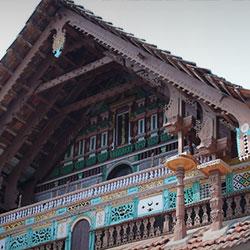
About The Thazhathangady Juma Masjid The Thazhathangady Juma Masjid, located in Kottayam, Kerala, is a famous mosque known for its beautiful architecture and historical significance. Built in traditional Kerala style of architecture, the mosque is a stunning example of the rich cultural heritage of the region. The mosque has been recognized for its unique wooden carvings, intricate artwork, and serene ambience, making it a popular tourist attraction. Architecture of Thazhathangady Juma Masjid The architecture of Thazhathangady Juma Masjid is a blend of traditional Kerala and Arab influences. The mosque is built entirely of wood, without the use of a single nail. The intricate wooden carvings on the walls, ceilings, and pillars are a sight to behold. The mosque also features a central courtyard, a small pond, and a prayer hall with beautiful rugs and calligraphy adorning the walls. History The Thazhathangady Juma Masjid has a rich history dating back over a thousand years. It is believed to have been established by the Arab traders who settled in the region for trade. The mosque has been renovated and expanded over the centuries, preserving its original charm and architectural beauty. The mosque has witnessed many historic events and continues to be a sacred place of worship for the local Muslim community. Best Time To Visit The best time to visit Thazhathangady Juma Masjid is during the winter months, from October to March, when the weather is pleasant and ideal for exploring the mosque and its surroundings. The annual Nercha festival, held in January, is a special time to visit the mosque, as it attracts a large number of devotees and tourists who come to witness the cultural performances and rituals. How To Reach Thazhathangady Juma Masjid is located in Kottayam, Kerala, and is easily accessible by road. The nearest airport is Cochin International Airport, which is about 80 kilometers away. The mosque is well-connected by road and can be reached by hiring a taxi or taking a local bus from Kottayam city. It is recommended to check the local transport options and plan your visit accordingly. Visitor Tips When visiting Thazhathangady Juma Masjid, it is important to dress modestly and respect the religious customs of the mosque. Visitors are required to remove their shoes before entering the prayer hall and maintain silence during prayers. It is also advisable to seek permission before taking photographs inside the mosque. Additionally, tourists are encouraged to explore the surrounding area, including the nearby backwaters and traditional villages, to get a glimpse of the local culture and way of life.
Explore More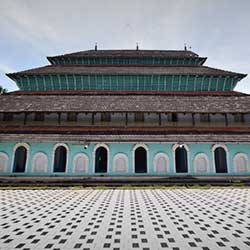
About The Mishkal Palli Mosque The Mishkal Palli Mosque, also known as Mishkal Mosque, is a historic mosque located in Kozhikode (Calicut), Kerala. It holds great significance for the Muslim community in the region and is known for its stunning architecture and cultural importance. Architecture of Mishkal Palli Mosque The Mishkal Palli Mosque is a fine example of traditional Kerala architecture with influences of Mughal and Arab styles. The mosque features a grand façade with intricate carvings and ornate decorations. The main prayer hall is spacious and well-lit, adorned with beautiful chandeliers and Persian rugs. The minaret of the mosque is tall and imposing, offering a panoramic view of the surrounding area. The architecture of Mishkal Palli Mosque reflects the rich cultural heritage of the region. History The Mishkal Palli Mosque was built in the 14th century by an Arab merchant named Nakhooda Mishkal. The mosque has stood the test of time and has witnessed many historic events in Kozhikode. It has served as a place of worship, education, and community gathering for generations of Muslims in the region. The mosque’s history is deeply intertwined with the cultural fabric of Kozhikode. Best Time To Visit The best time to visit the Mishkal Palli Mosque is during the holy month of Ramadan when the mosque is beautifully decorated and filled with worshippers. The atmosphere is vibrant and spiritual, making it a special time to experience the traditions and rituals of the Muslim community. Visitors can also explore the mosque during other times of the year and witness its architectural splendor. How To Reach The Mishkal Palli Mosque is located in the heart of Kozhikode city, making it easily accessible by road. Visitors can reach the mosque by taking a taxi, auto-rickshaw, or bus from any part of the city. The mosque is well-connected and is a popular tourist destination in Kozhikode. It is recommended to check with local authorities for any travel restrictions or guidelines before visiting the mosque. Visitor Tips When visiting the Mishkal Palli Mosque, it is important to dress modestly and respectfully. Visitors are required to remove their shoes before entering the mosque and follow the customs and traditions observed by the Muslim community. It is advised to maintain silence and refrain from any disruptive behavior while inside the mosque. Photography may be restricted in certain areas, so it is recommended to ask for permission before taking pictures. Visitors can also interact with the locals and learn more about the history and significance of the mosque. Overall, the Mishkal Palli Mosque is a symbol of religious harmony and architectural beauty in Kozhikode, attracting visitors from all walks of life to experience its rich culture and heritage.
Explore More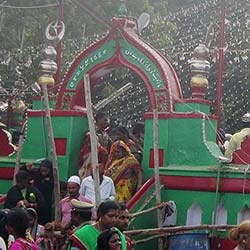
About The Bara Shaheed Dargah The Bara Shaheed Dargah, located in Nellore, is a historical and religious site that holds immense significance for the Muslim community in the region. The dargah, which translates to "shrine of twelve martyrs," is dedicated to twelve Sufi saints who sacrificed their lives for their beliefs. It is a place of reverence and pilgrimage for many followers of Islam, who come to pay their respects and seek blessings. Architecture of Bara Shaheed Dargah The architecture of the Bara Shaheed Dargah is a blend of traditional Islamic design elements and local influences. The main structure features a domed roof and intricately carved pillars, showcasing exquisite craftsmanship. The entrance is adorned with ornate carvings and colorful tiles, creating a striking visual appeal. Inside the dargah, visitors will find a peaceful courtyard surrounded by prayer halls and tombs of the revered saints. History The history of the Bara Shaheed Dargah dates back several centuries, with the exact origins shrouded in legend and folklore. According to popular belief, the twelve martyrs were warriors who fought valiantly in defense of their faith and were ultimately martyred for their beliefs. Over time, the dargah became a place of pilgrimage and worship, attracting devotees from far and wide. Best Time To Visit The best time to visit the Bara Shaheed Dargah is during the annual Urs (death anniversary) celebrations of the saints, which are marked by special prayers, rituals, and festivities. This typically falls in the Islamic month of Muharram and draws a large number of pilgrims and visitors to the dargah. The atmosphere during this time is charged with spirituality and devotion, making it a truly memorable experience. How To Reach The Bara Shaheed Dargah is located in Nellore, Andhra Pradesh, making it easily accessible by road, rail, and air. The nearest railway station is Nellore Railway Station, which is well-connected to major cities like Chennai, Hyderabad, and Bangalore. Visitors can also reach Nellore by road via national highways or opt for a flight to Tirupati Airport, which is the nearest airport to the city. Visitor Tips 1. Dress modestly and respectfully when visiting the dargah, as it is a sacred religious site. 2. Remove your shoes before entering the prayer halls or inner sanctum of the dargah. 3. Respect the customs and traditions of the local community, and seek permission before taking photographs. 4. Stay hydrated and carry sun protection, as Nellore can get quite hot and sunny, especially during the summer months. 5. Plan your visit during the Urs celebrations for a more enriching and immersive experience of the dargah's spiritual significance.
Explore More